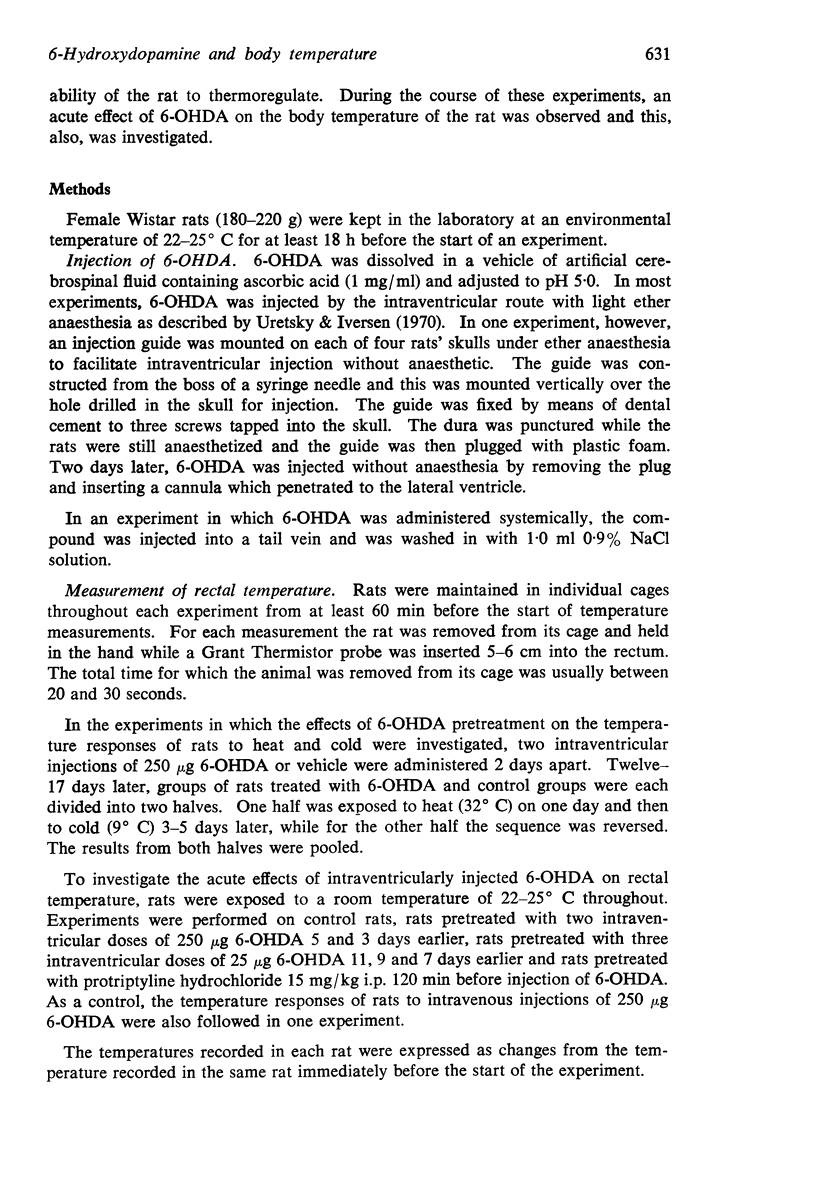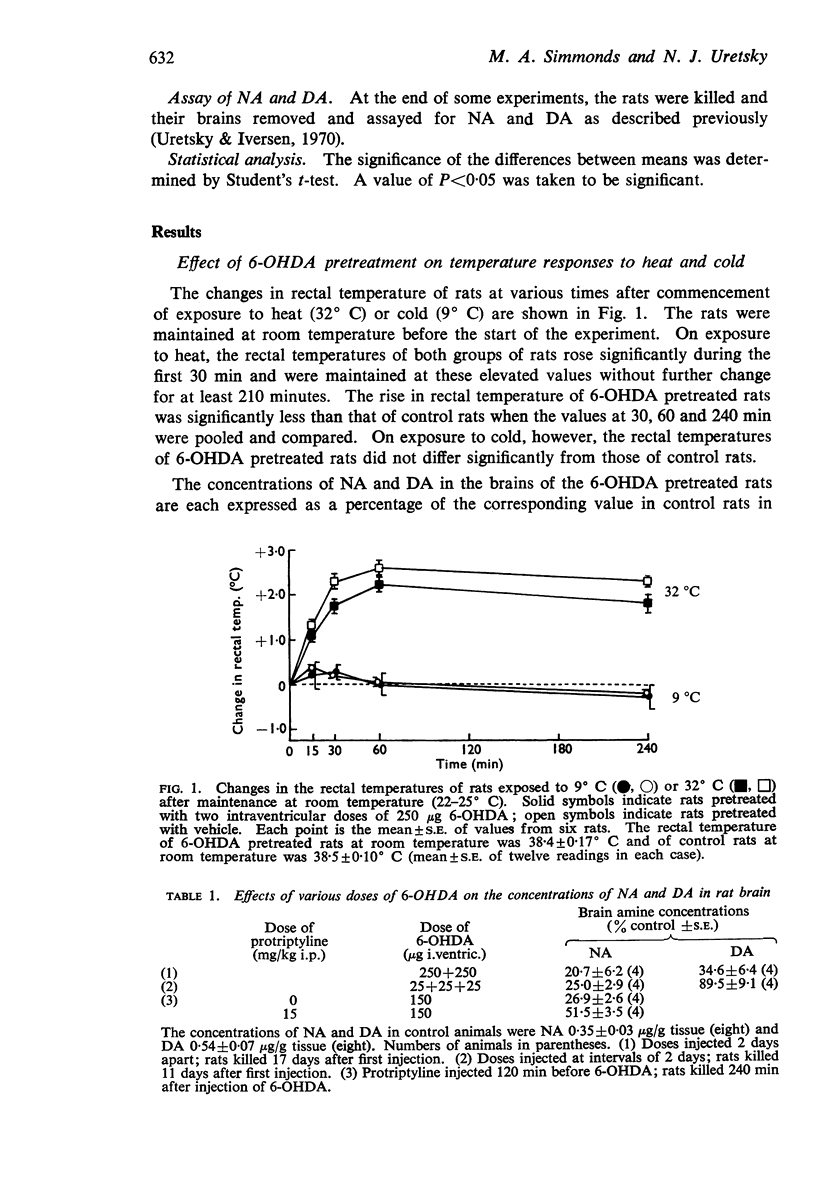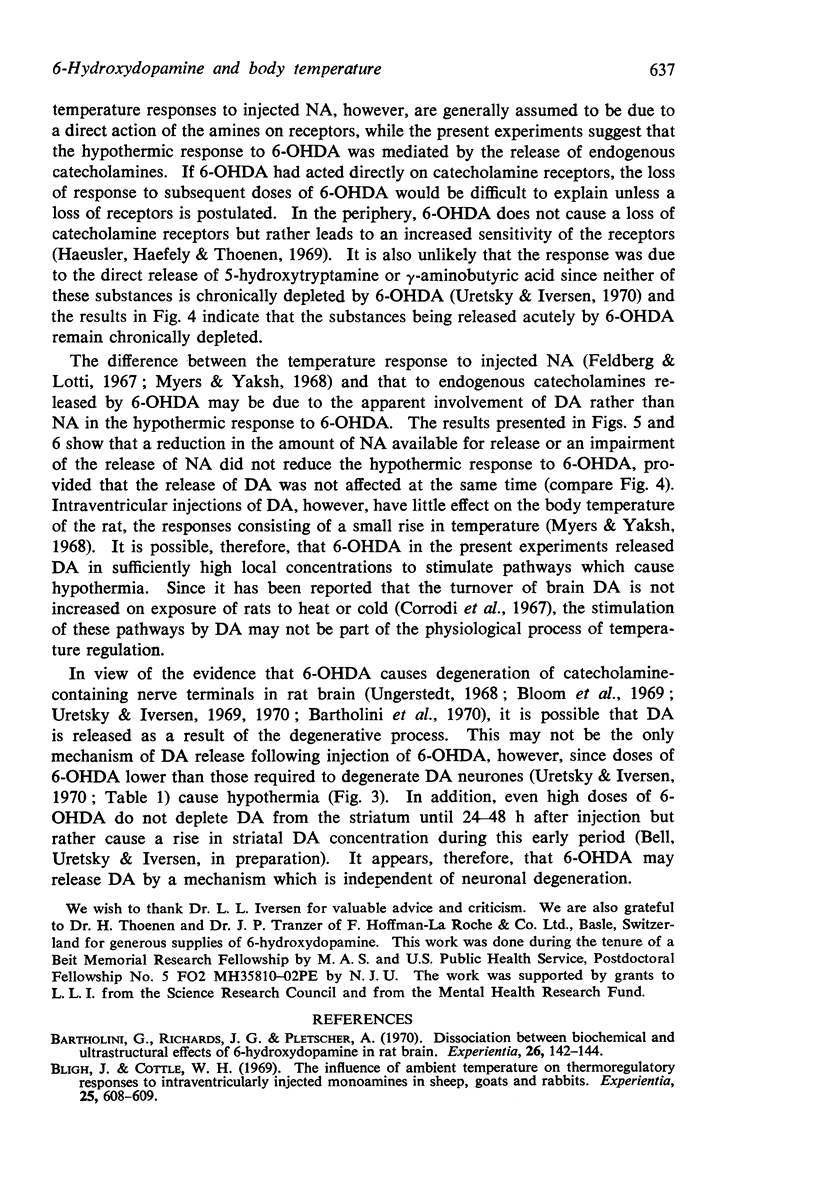Abstract
1. Rats which had been pretreated with intraventricular injections of 6-hydroxydopamine (6-OHDA) to cause a selective depletion of brain noradrenaline (NA) to 20·7% of control brain NA and brain dopamine (DA) to 34·6% of control brain DA retained an unimpaired ability to regulate their body temperatures on exposure to heat or cold. This is discussed in relation to the possible role of brain NA in the central control of body temperature.
2. Intraventricular injections of 6-OHDA in normal rats at room temperature caused an acute, dose dependent hypothermia of up to 4·5° C which lasted for 4-5 hours. Depletion of brain NA and DA by prior treatment with 6-OHDA markedly reduced the hypothermic response to a subsequent dose of 6-OHDA. Selective depletion of brain NA without affecting brain DA did not reduce the response to 6-OHDA. The acute hypothermic response to 6-OHDA, may therefore, be related to a release of DA in the brain.
Full text
PDF








Selected References
These references are in PubMed. This may not be the complete list of references from this article.
- Bartholini G., Richards J. G., Pletscher A. Dissociation between biochemical and ultrastructural effects of 6-hydroxydopamine in rat brain. Experientia. 1970;26(2):142–144. doi: 10.1007/BF01895541. [DOI] [PubMed] [Google Scholar]
- Bligh J., Cottle W. H. The influence of ambient temperature on thermoregulatory responses to intraventricularly injected monoamines in sheep, goats and rabbits. Experientia. 1969 Jun 15;25(6):608–609. doi: 10.1007/BF01896541. [DOI] [PubMed] [Google Scholar]
- Bloom F. E., Algeri S., Groppetti A., Revuelta A., Costa E. Lesions of central norepinephrine terminals with 6-OH-dopamine: biochemistry and fine structure. Science. 1969 Dec 5;166(3910):1284–1286. doi: 10.1126/science.166.3910.1284. [DOI] [PubMed] [Google Scholar]
- Corrodi H., Fuxe K., Hökfelt T. A possible role played by central monoamine neurones in thermo-regulation. Acta Physiol Scand. 1967 Oct-Nov;71(2):224–232. doi: 10.1111/j.1748-1716.1967.tb03728.x. [DOI] [PubMed] [Google Scholar]
- Duce M., Crabai F., Vargiu L., Piras L., Adamo F., Gessa G. L. Effetto dell'alfa-metil-m-tirosina sulle catecolamine di animali esposti al freddo. Boll Soc Ital Biol Sper. 1967 Dec 15;43(23):1607–1609. [PubMed] [Google Scholar]
- Evetts K. D., Iversen L. L. Effects of protriptyline on the depletion of catecholamines induced by 6-hydroxydopamine in the brain of the rat. J Pharm Pharmacol. 1970 Jul;22(7):540–543. doi: 10.1111/j.2042-7158.1970.tb10564.x. [DOI] [PubMed] [Google Scholar]
- Evetts K. D., Uretsky N. J., Iversen L. L., Iversen S. D. Effects of 6-hydroxydopamine on CNS catecholamines, spontaneous motor activity and amphetamine induced hyperactivity in rats. Nature. 1970 Mar 7;225(5236):961–962. doi: 10.1038/225961a0. [DOI] [PubMed] [Google Scholar]
- Feldberg W., Lotti V. J. Temperature responses to monoamines and an inhibitor of MAO injected into the cerebral ventricles of rats. Br J Pharmacol Chemother. 1967 Sep;31(1):152–161. doi: 10.1111/j.1476-5381.1967.tb01985.x. [DOI] [PMC free article] [PubMed] [Google Scholar]
- Gordon R., Spector S., Sjoerdsma A., Udenfriend S. Increased synthesis of norepinephrine and epinephrine in the intact rat during exercise and exposure to cold. J Pharmacol Exp Ther. 1966 Sep;153(3):440–447. [PubMed] [Google Scholar]
- Haeusler G., Haefely W., Thoenen H. Chemical sympathectomy of the cat with 6-hydroxydopamine. J Pharmacol Exp Ther. 1969 Nov;170(1):50–61. [PubMed] [Google Scholar]
- Hainsworth F. R. Saliva spreading, activity, and body temperature regulation in the rat. Am J Physiol. 1967 Jun;212(6):1288–1292. doi: 10.1152/ajplegacy.1967.212.6.1288. [DOI] [PubMed] [Google Scholar]
- Häggendal J., Hamberger B. Quantitative in vitro studies on noradrenaline uptake and its inhibition by amphetamine, desipramine and chlorpromazine. Acta Physiol Scand. 1967 Jul-Aug;70(3):277–280. doi: 10.1111/j.1748-1716.1967.tb03626.x. [DOI] [PubMed] [Google Scholar]
- Reid W. D., Volicer L., Smookler H., Beaven M. A., Brodie B. B. Brain amines and temperature regulation. Pharmacology. 1968;1(6):329–344. doi: 10.1159/000135983. [DOI] [PubMed] [Google Scholar]
- Ross S. B., Renyi A. L. Inhibition of the uptake of tritiated catecholamines by antidepressant and related agents. Eur J Pharmacol. 1967 Dec;2(3):181–186. doi: 10.1016/0014-2999(67)90084-2. [DOI] [PubMed] [Google Scholar]
- Simmonds M. A. Effect of environmental temperature on the turnover of noradrenaline in hypothalamus and other areas of rat brain. J Physiol. 1969 Jul;203(1):199–210. doi: 10.1113/jphysiol.1969.sp008859. [DOI] [PMC free article] [PubMed] [Google Scholar]
- Snyder S. H., Green A. I., Hendley E. D. Kinetics of H3-norepinephrine accumulation into slices from different regions of the rat brain. J Pharmacol Exp Ther. 1968 Nov;164(1):90–102. [PubMed] [Google Scholar]
- Thoenen H., Tranzer J. P. Chemical sympathectomy by selective destruction of adrenergic nerve endings with 6-Hydroxydopamine. Naunyn Schmiedebergs Arch Exp Pathol Pharmakol. 1968;261(3):271–288. doi: 10.1007/BF00536990. [DOI] [PubMed] [Google Scholar]
- Ungerstedt U. 6-Hydroxy-dopamine induced degeneration of central monoamine neurons. Eur J Pharmacol. 1968 Dec;5(1):107–110. doi: 10.1016/0014-2999(68)90164-7. [DOI] [PubMed] [Google Scholar]
- Uretsky N. J., Iversen L. L. Effects of 6-hydroxydopamine on catecholamine containing neurones in the rat brain. J Neurochem. 1970 Feb;17(2):269–278. doi: 10.1111/j.1471-4159.1970.tb02210.x. [DOI] [PubMed] [Google Scholar]
- Uretsky N. J., Iversen L. L. Effects of 6-hydroxydopamine on noradrenaline-containing neurones in the rat brain. Nature. 1969 Feb 8;221(5180):557–559. doi: 10.1038/221557a0. [DOI] [PubMed] [Google Scholar]


